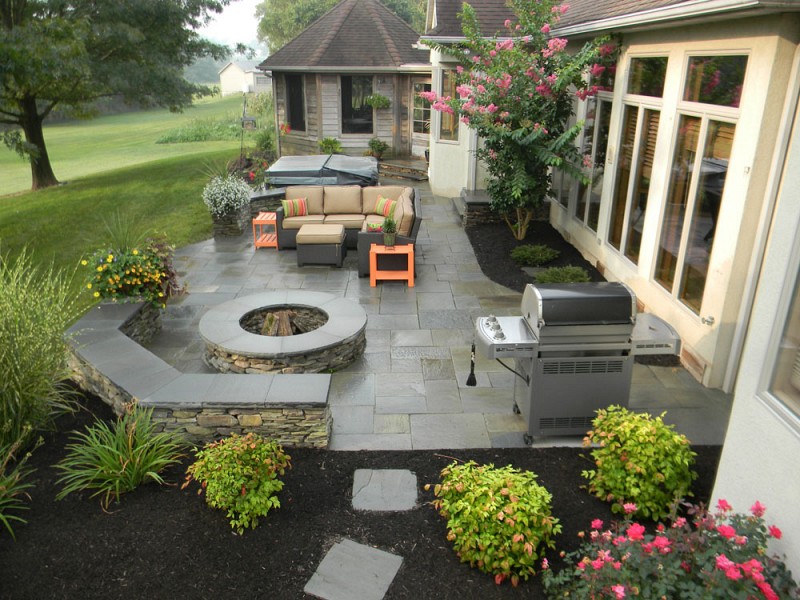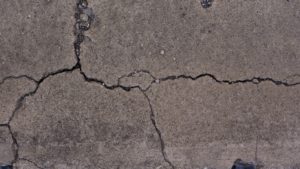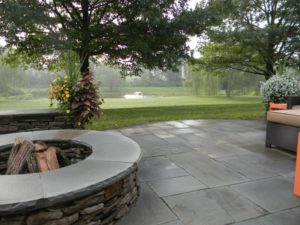
Patio Paver versus A Stamped Concrete Patio – Which is Better For Me?
February 12, 2016Potential and current customers frequently ask us if they should choose patio pavers or a stamped concrete patio. There’s no simple answer because every homeowner has different desires and expectations, so we begin to help them choose by explaining the significant differences between these two materials. Let’s clarify that “pavers” is a generic term for interlocking concrete pavers. Patio pavers are manmade from high-strength concrete and come in an almost infinite variety of shapes, thicknesses, textures and colors. We use pavers frequently, and we also construct many hardscapes from natural stone materials, using similar installation techniques.
Costs
Let’s get right to it; many people assume that a stamped concrete patio will be less expensive than a paver patio. In some cases, they will be right but since no two design/installations are the same, it’s not really possible to make this judgment without some research. It’s also not really an apples-to-apples comparison, as we will explain.
Construction
The most important part of any patio installation, regardless of material type, is the base. This is the foundation of the final surface and as the saying goes, what you see is “only as strong as its foundation”.
Poured monolithic slab concrete, whether or not it is decoratively stamped, requires a base. This base typically consists of a shallow excavation of 4-6” in depth. This is then backfilled with ¼ clean limestone with a piece of reinforcing wire mesh overlaid on the stone. The concrete is poured and formed over this base and allowed to cure. If decorative stamping is desired, it is done while the concrete is being poured/formed. That’s it.
Patio pavers share a similar first step in excavation, but even this step is different.
Excavation – For the majority of paver installations, excavations are deeper than for concrete, typically 6-8” depending on soil type and desired load limits (deeper for vehicular traffic applications). Once excavation is complete, soil barrier or geotextile fabric is placed over the excavated area. This step limits the infiltration of native soils into the backfill materials and helps minimize future settling of the finished surface.
Backfill – For a paver installation, crushed limestone (often called 2A or Modified) is installed over this geotextile in specific layers or “lifts” that are each mechanically compacted to a specific density. Once this step is completed to the desired grade, a final layer of bedding material, typically coarse construction sand, is placed over the base. This allows the pavers to be tamped into place and creates a level surface and tight fit.
Finish Sweep – Most paver installations require a material to fill the gap between the individual pavers. Over the past 10-15 years, the hardscape industry has created materials specifically for this purpose with the most commonly used material currently being poly-sand. This is a fine grain sand mixed with a polymeric material that binds the sand to itself and the pavers when wetted after installation. This poly-sand acts as a weed barrier while remaining flexible and locking the pavers together.
As you can see, there are some major differences in how pavers are installed, compared to stamped concrete. Even so, the most important difference is not obvious: Patio pavers are not a single unit and can move and flex independently of one another. A monolithic slab of concrete cannot.
 And why does this matter? The answer is the thermometer. We live in an area that is subject to annual freeze/thaw cycles and these forces will move almost anything. You know those “cracks” in a concrete sidewalk? They aren’t there just to look pretty. They’re actually stress release joints installed specifically to allow the concrete to crack during freeze/thaw cycles.
And why does this matter? The answer is the thermometer. We live in an area that is subject to annual freeze/thaw cycles and these forces will move almost anything. You know those “cracks” in a concrete sidewalk? They aren’t there just to look pretty. They’re actually stress release joints installed specifically to allow the concrete to crack during freeze/thaw cycles.
These joints are designed to crack first so that the entire sidewalk doesn’t have cracks all over it. Even this “designed” cracking can’t always stop other cracking. And ANY crack allows water in to the concrete which eventually freezes and causes flaking or spalling. Once this begins, it is irreversible in concrete, and the only fix is to remove and start over. Granted, this process may take years, but why install something that is almost designed to fail?
Patio pavers, on the other hand, can move with the freeze/thaw cycle and will not crack. If an individual paver is damaged, it can be lifted out and replaced. If an entire area is undermined, the area can be removed, the base repaired and the pavers re-installed.
Appearance
Stamped concrete offers many designs and colors, which are created during the installation process. Rubber stamp pads are used to repeat a pattern of your choice on wet concrete. Pigments are used to color the top of the concrete to give the desired color to the finished product. This process can allow coloration to wear over time.
 Pavers are formed in a high pressure industrial press, creating an extremely dense and durable unit. These units are sometimes textured during this process but typically they are given the final texture through mechanical texturing, tumbling, chiseling or breaking. Occasionally, they are “wet formed” like poured concrete, in individual forms. Most pavers are full color, meaning the pigments that give them color are mixed throughout the paver and therefore will not flake, peel or chip off.
Pavers are formed in a high pressure industrial press, creating an extremely dense and durable unit. These units are sometimes textured during this process but typically they are given the final texture through mechanical texturing, tumbling, chiseling or breaking. Occasionally, they are “wet formed” like poured concrete, in individual forms. Most pavers are full color, meaning the pigments that give them color are mixed throughout the paver and therefore will not flake, peel or chip off.
As you can see, there are many differences between these two products. It is important to look beyond the price to be sure that the product you receive will meet your needs and add value to your property over the long term. Regardless of how you choose to proceed, the most important step is to be sure you are working with a reputable and reliable landscape contractor that is a certified paver installer who will deliver a quality product and stand behind it. Visit www.icpi.org for a listing of local contractors who are nationally certified installers.